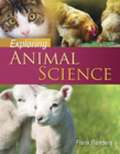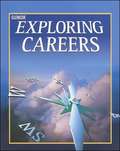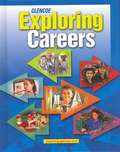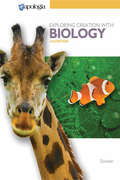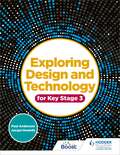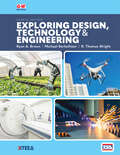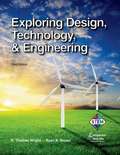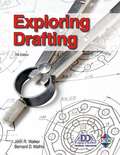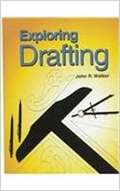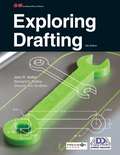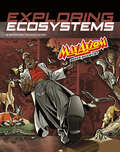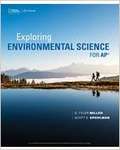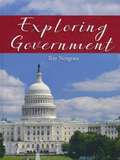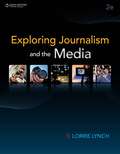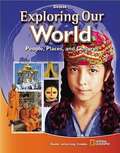- Table View
- List View
Exploring America, Part 2 (Late 1800's to Present)
by Ray NotgrassThis curriculum will guide you through the story of our country from the first European explorers to the present. We place great emphasis on original documents and speeches because these allow the participants in history to tell the story from their own perspective. This curriculum also introduces some of the great literature that Americans have produced: novels, short stories, autobiographies, memoirs, essays, poems, hymns, and other kinds of writing. The written and spoken word has a profound ability to move hearts and minds. This course also explores the significance of faith with regard to history. Faith is connected with history in two ways. First, people have often been motivated to act because of their faith in God. For instance, faith motivated the Pilgrims on the Mayflower to seek a new land in which to live. Faith caused people to oppose slavery. Faith has been expressed often in the speeches and documents that Americans have produced. We recognize and highlight the importance of faith throughout the American story. A second way that faith should be connected to history is by looking at the overall story of American history through the eyes of faith. We encourage students to think about the faith lessons that they can learn from people and events in history. For instance, many God-fearing Americans owned slaves and had a strong prejudice against blacks. We need to understand what caused those Christian people to be blinded by their culture and how they missed the example of Jesus and the teaching of Scripture about this issue (see John 4:7-9, Galatians 3:28, and Ephesians 2:19). This might help us realize cultural blindnesses we suffer today. A study of history can inform, challenge, and strengthen our own faith. "
Exploring American History
by John O'ConnorIn this book you will read the story of your country from its beginnings to the present day. The people who tell this story are called historians. You may wonder how historians find out what happened in the past. Historians are like detectives. They use many kinds of clues to learn about the way people lived and what they did in years gone by.
Exploring Animal Science
by Frank B. FlandersEXPLORING ANIMAL SCIENCE offers educators the perfect tool for teaching animal agriculture: one that balances the academic background critical to building a strong foundation in fundamental science with the practical, production-oriented content vital to work in the real world. Its coverage spans a variety of areas like nutrition, anatomy and physiology, biotechnology, biosecurity, and genetics and animal reproduction. Each topic is presented in a straightforward manner that first investigates the basics, and then delves further into its practical application to the production, care, and management of animal agriculture. Ideal for a range of students, from late middle school to early high school, this unique approach is sure to engage by drawing such powerful connections between academics and real-life animal-based scenarios and situations. It also includes a wide range of activities that will fit any animal science classroom, making it an appealing choice for teachers and students alike.
Exploring Careers (3rd Edition)
by Joan Kelly-Plate Ruth Volz-PattonThis completely revised middle school career education program, formerly titled Career Skills, motivates your students to investigate career opportunities they might pursue in the future.
Exploring Careers (4th edition)
by Joan Kelly-Plate Ruth Volz-PattonThis text prepares students for the rapidly changing opportunities in the world of work. As they explore each of the 16 U. S. Department of Education career clusters, they'll build foundation skills and workplace competencies as they learn how each new skill can help them build successful careers. Attractive visuals and an easy-to-read style invite students of all backgrounds and abilities to explore the content.
Exploring Careers in Dentistry
by Jessica A. RickertDiscusses the profession of dentistry and offers advice to those interested in dentistry as a career.
Exploring Creation with Biology
by Vicki DincherAs scientific studies advance farther out into the universe as well as deeper into the microscopic world, scientists continue to ask, “What is life?” Biology is the study of life, and this 3rd edition of Exploring Creation with Biology teaches not only the science of how we begin to answer the bigger questions defining life, but also includes meaningful discussions on Creation and Creator. <p><p> This updated high school biology course was redesigned to help students see and understand the beauty of life that surrounds us. Full-page infographics were created to help students grasp the concepts discussed in the text and go beyond simple illustrations. <p> As a college-prep high school biology course, it will set the stage for success in homeschooled high school years, prepare students for college level courses, and give them an understanding of the basic biological world that surrounds them each day of their lives so that they can appreciate the real-world relevance of scientific inquiry. <p> Opening with the studies of the process of science, students learn about observations and inferences, hypotheses, experiments, and scientific theories and laws. They are taught to see the limitations of science and learn about the tools used in biological studies. <p> In their studies of life, students will delve into the chemistry of life from atoms to the chemical structures that make life, as we know it, possible. They will explore the ecology that surrounds life as they investigate ecosystems, biomes, populations, and communities. <p> An in-depth study of cell structure and function, cellular energy, DNA, proteins, and cell cycles will help students comprehend heartier materials as they advance to learn about genetics – inheritance, disorders, and technology, as well as the role of genetics in evolution. <p> Students will also learn about prokaryotes, viruses, protists, and fungi. They will delve deep into the fascinating world of plants and animals. And all of their learned knowledge will be backed by hands-on experimentation that takes their book knowledge and applies it to concepts that they can comprehend. <p> At Apologia, we believe that students’ educations should prepare them for life, not just an academic year. This creation-based science course will create the strong foundation students can rely upon as they grow in their awe and wonder of our world. <p> At the completion of this course, students will be able to understand the vocabulary of biology so that they can engage in true scientific discourse. Their strong background in the scientific method regarding experimentation, field studies, microscopy, and dissection will also allow them to be well equipped to analyze data that they will encounter throughout their lifetimes.
Exploring Design and Technology for Key Stage 3
by Paul Anderson Jacqui HowellsDevelop knowledge, understanding and designing and making skills through Key Stage 3 so students are ready for the new GCSE in Design and Technology, with our brand-new Student Book.With topics directly linked to the new GCSE (9-1) specifications, Exploring Design and Technology will build a solid foundation by boosting your students' understanding of the key concepts, introducing them to important terminology and developing their practical skills through Key Stage 3.· Build understanding through years 7, 8 and 9 with engaging, carefully timed and level-appropriate lessons that draw on the GCSE subject content.· Develop practical skills with a variety of creative designing and making activities that use a wide range of materials, tools, equipment and processes. · Boost knowledge with clear explanations of important terminology and concepts that students will need to apply when identifying design problems, understanding user needs and developing design solutions in a range of contexts.· Encourage subject interest with 'find out more' - research features that broaden understanding of materials and their working properties, new technologies and the wider influences on designing and making.· Monitor and measure student progress with knowledge check questions provided for every topic.
Exploring Design Technology and Engineering
by Ryan A. Brown Michael Berkeihiser R. Thomas WrightIntroduction to Anatomy and Physiology covers all body systems using a student-friendly writing style that makes complex subjects easier to understand. Written specifically for the high school market, the chapters in this textbook are divided into lessons, providing content in a manageable format for the student. Each lesson is further divided into subtopics, with questions at the end of each subtopic to help students gauge their understanding of the material. Clinical case studies and real-world applications enhance student interest and involvement. An outstanding illustration program includes anatomically exact drawings with great use of color, simplified labeling, and teaching captions. Strong pedagogy includes study aids, such as learning objectives, lesson summaries, and extensive assessment opportunities increase students’ ability to succeed in this challenging course. This edition has been updated to include content on the impact of COVID-19, artificial tissues, muscle disorders, the sense of touch, and Rh factor to the universal donor and universal recipient definitions.
Exploring Design, Technology, & Engineering
by R. Thomas Wright Ryan A. BrownExploring Design, Technology, and Engineering is an exciting introductory technology education text that provides in-depth coverage of the content defined in the Standards for Technological Literacy. Coverage includes the impacts of technology, technological systems, the history of technology,applying technology, and the designed world (agriculture and biotechnology, construction, manufacturing, information and communication, transportation, energy and power, and medical technology). This edition includes updated information o job skills, technological needs and wants, and technologicalimpacts.
Exploring Drafting
by John R. Walker Bernard D. MathisExploring Drafting is designed for use in introductory drafting courses at any instructional level. This text provides a strong foundation in drafting fundamentals and teaches essential manual (traditional) and CAD drafting skills. Coverage includes detailed instruction on geometric constructions, orthographic projection, and dimensioning practices. The text covers techniques and procedures used in creating multiview drawings, section views, auxiliary views, pictorial views, and pattern developments. End-of-chapter drawing problems reinforce the chapter content and help students build problem-solving skills. Exploring Drafting features a colorful, highly illustrated design to promote student interest.
Exploring Drafting: Fundamentals Of Drafting Technology
by John R. Walker Bernard D. MathisExploring Drafting has been extensively revised to provide improved and expanded CAD drafting content, while retaining its strong emphasis on drafting fundamentals and basic drafting techniques. It introduces the basic drawing practices and skills used by drafters. Designed for introductory drafting students at any instructional level, this textbook teaches the fundamentals used to create drawings. It shows students how to apply sketching methods, line conventions, and industry standards to solve drawing problems. The book provides instruction on geometric constructions, orthographic views, dimensioning, pictorial drawing, pattern development, and computer-aided drafting (CAD). It introduces students to common drafting tools and the basic applications of CAD. This textbook emphasizes the importance of learning basic manual skills before progressing to CAD applications. Coverage addresses the practices and techniques used in a variety of different drafting disciplines, including mechanical drafting, architectural drafting, electrical and electronics drafting, welding drafting, and graphic design. Numerous examples of drawings from industry are presented in this heavily illustrated text.
Exploring Drafting: Teaching Package Worksheets
by John R. Walker Bernard D. Mathis Shauna Ann ScribnerNIMAC-sourced textbook
Exploring Drafting
by John R. Walker Bernard D. Mathis Shauna Ann ScribnerExploring Drafting is designed for use in introductory courses as it stresses fundamental skills appropriate for beginning drafting students at any instructional level and teaches both manual and CAD drafting skills. Coverage includes basic geometric constructions, orthographic projection, and dimensioning practices. Techniques and procedures used in creating Multiview drawings, sectional views, pictorial views, and pattern developments are taught. The end-of-chapter drawing problems help student build problem-solving skills and practice drafting techniques. The text follows ASME practices and serves as an ADDA approved publication.
Exploring Ecosystems with Max Axiom Super Scientist: 4d An Augmented Reading Science Experience (Graphic Science 4d Ser.)
by Agnieszka BiskupTrek along with Max as he explores the Earth's many ecosystems. Journeying to the desert, the tundra, even the depths of the sea, young readers will discover the world's many wonderful biomes. Download the free Capstone 4D app for an augmented reality experience that goes beyond the printed page. Videos, writing prompts, discussion questions, and hands-on activities make this updated edition come alive and keep your collection current.
Exploring Environmental Science for AP®
by G. Miller Scott SpoolmanNIMAC-sourced textbook <P><P>Written specifically for the AP Environmental Science course, authors Tyler Miller and Scott Spoolman connect the themes of economics, politics, ethics, policy, and sustainability together for an engaging and thorough presentation of environmental science concepts. Features to assist students in preparing for the AP exam for Environmental Science include Multiple Choice and Free-Response review questions at the end of each chapter and unit, and a full AP Practice Test at the end of the book.
Exploring Environmental Science for AP
by G. Tyler Miller Scott E. SpoolmanNIMAC-sourced textbook <p>Updated Edition</p>
Exploring Government
by Ray NotgrassThe Notgrass Company Exploring Government curriculum is a one-semester (half-credit) high school course that covers the government of the United States from its beginning to the present with a special emphasis on the Biblical pattern for government and the U.S. Constitution. Students will learn about federal, state, and local government and become better equipped to understand our country's government as they learn about contemporary issues facing our nation today. This Exploring Government textbook includes 75 lessons. At the beginning of each unit, an introduction, list of books used in the unit, project literature assignments, and any additional assignments are laid out; these overarching assignments are broken up into daily tasks given at the end of each day's reading.
Exploring Journalism and the Media
by Lorrie LynchIntroduce your students to the exciting world of journalism using the hands-on, relevant approach of EXPLORING JOURNALISM AND THE MEDIA, 2e. The instructional model presents timeless concepts and applications that will prepare students for scholastic journalism, as well as lay the ground work for future classes, jobs, and careers. Author Lorrie Lynch's experience as a USA Today journalist gives a unique perspective absent from most other journalism textbooks. Profiles of real journalists, authentic student writings from scholastic publications, 21st Century Career Skills, and discussion on legal issues and editorial ethics will help students connect to the curriculum. EXPLORING JOURNALISM AND THE MEDIA, 2e will not only introduce students to the many different journalism career opportunities, but will also help them perform better in the classroom by providing academic connections, grammar tips, critical thinking activities, and writing activities.
Exploring Journalism and the Media
by Lorrie LynchIntroduce your students to the exciting world of journalism using the hands-on, relevant approach of EXPLORING JOURNALISM AND THE MEDIA, 2e. The instructional model presents timeless concepts and applications that will prepare students for scholastic journalism, as well as lay the ground work for future classes, jobs, and careers. Author Lorrie Lynch's experience as a USA Today journalist gives a unique perspective absent from most other journalism textbooks. Profiles of real journalists, authentic student writings from scholastic publications, 21st Century Career Skills, and discussion on legal issues and editorial ethics will help students connect to the curriculum. EXPLORING JOURNALISM AND THE MEDIA, 2e will not only introduce students to the many different journalism career opportunities, but will also help them perform better in the classroom by providing academic connections, grammar tips, critical thinking activities, and writing activities.
Exploring Matter and Energy
by Michael Anthony Dispezio Sparks Skoog Et. AlThe book explores different aspects of matter and energy as heat, electricity, nuclear chemistry, Atoms, Elements, Compounds, and Mixtures among other subjects. Each chapter provides the students with different activities and review questions, concept maps that help students study and remember what they learn as well as assist them in organizing information in each chapter visually.
Exploring Our World: People, Places, and Cultures
by Richard G. Boehm David G. Armstrong Francis P. HunkinsWorld geography, world cultures. . . a world students can understand. Exploring Our World is a middle school program co-authored by National Geographic. This program introduces students to an enriched view of the interrelationships of geography, history, economics, government, citizenship, and current events in one compelling package. A strong geographic thread is interwoven with history, government, and current events to analyze different regions of the world and the issues they face. Suitable for a world geography or world cultures class, Exploring Our World is available as a full survey; Eastern Hemisphere; and Western Hemisphere, Europe, and Russia.
Exploring Plate Tectonics, Student Guide
by National Science Resources Center Meg Town John NortonNIMAC-sourced textbook
Exploring Respiration and Circulation, Student Guide
by National Science Resources Center Wordwise Inc. Taina LitwakNIMAC-sourced textbook

